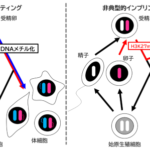POLQは重イオン照射による複雑なDNA二本鎖切断を修復する。 POLQ Repairs Complex DNA Double-strand Breaks Induced by Heavy Ion Irradiation
2023-03-17 韓国基礎科学研究院(IBS)
高線量放射線療法は、炭素イオンのような荷電した重い粒子を利用する放射線療法で、従来の放射線治療とは異なり、新しいDNA損傷を引き起こす。炭素イオンは高LET(線形エネルギー伝達)を有し、そのエネルギーは短距離で集中し、腫瘍細胞にのみ影響を与え、周囲の正常な組織への損傷を最小限に抑えることができる。しかし、DNAの損傷は従来の放射線治療よりも複雑であり、がん細胞が修復するのが難しい。
高田教授の研究チームは、ポリメラーゼθ(POLQ)が高LET放射線による複雑なDNA二本鎖切断(DSB)の修復に重要な因子であることを発見した。POLQは、マイクロホモロジー介在末端結合を実行できる唯一のDNAポリメラーゼで、これにより、複雑なDSB修復が可能になる。
この発見は、新しい放射線治療をより効果的にするためのがん細胞の修復メカニズムのブロックにつながる可能性がある。
<関連情報>
- https://www.ibs.re.kr/cop/bbs/BBSMSTR_000000000738/selectBoardArticle.do?nttId=22604&pageIndex=1&searchCnd=&searchWrd=
- https://academic.oup.com/nar/article/51/5/2257/7048507?login=false
高LET放射線誘発複合DNA二本鎖切断のDNAポリメラーゼθによる修復 DNA polymerase θ-mediated repair of high LET radiation-induced complex DNA double-strand breaks
Geunil Yi, Yubin Sung, Chanwoo Kim, Jae Sun Ra, Hirokazu Hirakawa, Takamitsu A Kato, Akira Fujimori, Hajin Kim, Kei-ichi Takata
Nucleic Acids Research Published:20 February 2023
DOI:https://doi.org/10.1093/nar/gkad076

Abstract
DNA polymerase θ (POLQ) is a unique DNA polymerase that is able to perform microhomology-mediated end-joining as well as translesion synthesis (TLS) across an abasic (AP) site and thymine glycol (Tg). However, the biological significance of the TLS activity is currently unknown. Herein we provide evidence that the TLS activity of POLQ plays a critical role in repairing complex DNA double-strand breaks (DSBs) induced by high linear energy transfer (LET) radiation. Radiotherapy with high LET radiation such as carbon ions leads to more deleterious biological effects than corresponding doses of low LET radiation such as X-rays. High LET-induced DSBs are considered to be complex, carrying additional DNA damage such as AP site and Tg in close proximity to the DSB sites. However, it is not clearly understood how complex DSBs are processed in mammalian cells. We demonstrated that genetic disruption of POLQ results in an increase of chromatid breaks and enhanced cellular sensitivity following treatment with high LET radiation. At the biochemical level, POLQ was able to bypass an AP site and Tg during end-joining and was able to anneal two single-stranded DNA tails when DNA lesions were located outside the microhomology. This study offers evidence that POLQ is directly involved in the repair of complex DSBs.


